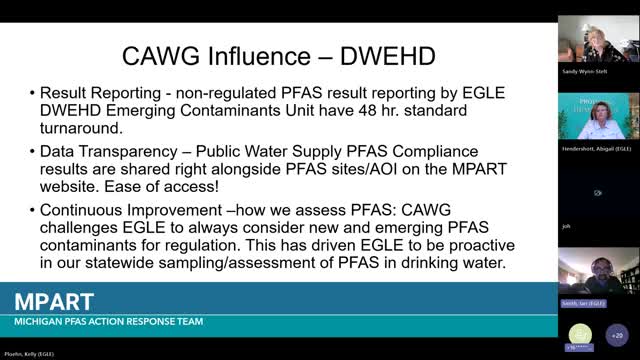Advocates demand urgent action on PFAS public notification
August 15, 2024 | Environment, Great Lakes, and Energy, Boards and Commissions, Organizations , Executive, Michigan
This article was created by AI summarizing key points discussed. AI makes mistakes, so for full details and context, please refer to the video of the full meeting. Please report any errors so we can fix them. Report an error »

In a recent government meeting, officials discussed ongoing efforts to address emerging contaminants, particularly PFAS (per- and polyfluoroalkyl substances), and the need for improved public notification regarding contaminated sites. The Emerging Contaminants Unit emphasized its commitment to identifying new PFAS compounds and enhancing resources to better assess their impact on sensitive drinking water sources.
Jocelyn Marzek from the Michigan Department of Health and Human Services (MDHHs) highlighted the incorporation of community feedback into their communication strategies, which aim to improve public health education and site-specific information dissemination. This feedback has been instrumental in shaping their programmatic communications plan.
Participants acknowledged the progress made in identifying PFAS sites, but expressed concerns about the adequacy of public notifications. Theresa Landrum noted that while there has been an increase in awareness of PFAS sites, timely public notification remains a critical issue. Mary echoed this sentiment, commending individual agency staff for their efforts while stressing the importance of community engagement in setting goals.
Lynn raised concerns about the effectiveness of current outreach efforts, emphasizing the need for better communication with residents during site investigations. She called for a renewed focus on public notification and resource allocation to ensure that communities are informed and can take necessary precautions regarding water safety.
The meeting concluded with a commitment to push for additional funding and improved public notification protocols, reflecting a collective desire to enhance community awareness and response to PFAS contamination. The discussions underscored the importance of collaboration between government agencies and community members in addressing environmental health challenges.
Jocelyn Marzek from the Michigan Department of Health and Human Services (MDHHs) highlighted the incorporation of community feedback into their communication strategies, which aim to improve public health education and site-specific information dissemination. This feedback has been instrumental in shaping their programmatic communications plan.
Participants acknowledged the progress made in identifying PFAS sites, but expressed concerns about the adequacy of public notifications. Theresa Landrum noted that while there has been an increase in awareness of PFAS sites, timely public notification remains a critical issue. Mary echoed this sentiment, commending individual agency staff for their efforts while stressing the importance of community engagement in setting goals.
Lynn raised concerns about the effectiveness of current outreach efforts, emphasizing the need for better communication with residents during site investigations. She called for a renewed focus on public notification and resource allocation to ensure that communities are informed and can take necessary precautions regarding water safety.
The meeting concluded with a commitment to push for additional funding and improved public notification protocols, reflecting a collective desire to enhance community awareness and response to PFAS contamination. The discussions underscored the importance of collaboration between government agencies and community members in addressing environmental health challenges.
View full meeting
This article is based on a recent meeting—watch the full video and explore the complete transcript for deeper insights into the discussion.
View full meeting
